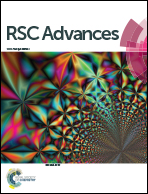CRANAD-1 as a cyanide sensor in aqueous media: a theoretical study†
Abstract
The lethal toxicity of cyanide ions to animals and the environment has led to considerable research into the development of methods for rapid and sensitive cyanide detection. CRANAD-1, 2,2-difluoro-4,6-bis[β-(4-hydroxy-3-methoxystyryl)]-1,3,2-dioxaborine has been demonstrated experimentally as a specific sensor for cyanide ion. However, the theoretical explanation for this phenomenon will help us to unfold the mechanism of interaction further. Detailed investigation on the binding energies of CRANAD-1 in presence of various anions such as CN−, F−, Cl−, Br−, AcO−, SCN− and NO3− in acetonitrile–water 4 : 1 (v/v) was carried out using B3LYP level of density functional theory using SDD and 6-311++G** as basis sets. The results revealed the H-bond formation of phenolic –OH of CRANAD-1 with cyanide ion, lead to selective sensing of CN− ion with minimum energy. The λmax absorption values calculated from B3LYP/SDD also support experimental reports of selective sensing of CN− compared to other anions with Δλmax = 85.72 nm and it confirms that the 1 : 2 complex is more stable. The comparison of binding energies of cyanide complexes of 4-hydroxy-3-methoxystyrene and CRANAD-1 reveals better cyanide sensing of Donor–Acceptor–Donor (D–A–D) system, CRANAD-1. The Nuclear Independent Chemical Shift (NICS) calculation confirms the quinonoid structure conversion of phenyl ring and Natural Bond Orbital (NBO) analysis confirms the charge transfer (CT) from CN− to CRANAD-1 is more.


 Please wait while we load your content...
Please wait while we load your content...